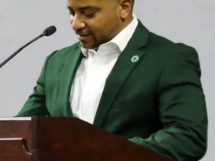Documented scanned by UofL for appraisal and to prepare for museum display
LOUISVILLE (Feb. 14, 2012) – The city’s rare copy of the “Declaration of Independence” was briefly transported from its home at Metro Hall last week to be professionally scanned by the imaging manager at the University of Louisville’s photo archives department.
With the cooperation of Metro Louisville’s facilities crew and archives staff, Speed Museum personnel and Ekstrom Library’s photo archives department, the copy was removed from its display case, transported, scanned in high definition, and returned to its secured location in about three hours.
The move was not publicized before hand to minimize security concerns for the document, one of just 31 of the most important early copies of the Declaration.
“It felt like a James Bond mission,” said Missy O’Brien, Archives Supervisor for Metro Government Archives and Record Center, with a laugh. “But the mission in this case was to make sure we properly care for this national, archival treasure.”
Throughout the journey, the document was kept in a double-sided glass frame, covered in bubble wrap, then cardboard, and finally wrapped in a quilt. As it was carried through the city, the priceless document rolled past college students drinking coffee as they studied in the library, downtown workers crossing the street on their way to grab lunch and the Occupy Louisville protestors at Founders Square.
Efforts were taken to keep it at a consistent temperature as it moved from its warm home at Metro Hall to the van and then the library.
O’Brien said the scanning was performed for two reasons. The high-definition image will help get the document properly appraised so that the city can make sure it is appropriately insured. And secondly, it will help experts evaluate what might need to be done to repair damage to the document without traveling to Louisville.
“This document is obviously priceless,” said Mayor Greg Fischer. “And we have a responsibility to be good stewards of it – both a responsibility to the citizens of Louisville, but to the nation as as a whole.”
Bill Carner, the imaging manager at the U of L Photographic Archives, said the scan was made using a German camera and an American-made BetterLight scanning back. With a camera fixed above the document, a series of pictures was taken that created an image which could be enlarged to 300 percent before becoming even slightly pixelated.
The University of Louisville did not charge for the service. One of the challenges was that the crew was unable to remove metal brackets from the back of the document frame – brackets that hold it up in the display case – so the image would not lie flat. But the University Archives and Records Center staff used encyclopedias and other books to form a make-shift pedestal that solved the problem.
The Speed Museum has requested that the Declaration be loaned to them for a future exhibit called “The Spirit of Independence.” In the meantime, however, the Declaration is, as always, available for viewing by the public in Metro Hall, for free. If you enter the front doors of Metro Hall, it can be found on the right side of the Rotunda. The display case lights have been turned off to better protect the document, but it can still be read in the general overhead lighting of the building.
WHY IS THIS COPY SPECIAL?
Although not the original, this copy of the Declaration is rare, unusual and considered very valuable. Made in 1823 by an engraver named William Stone, this copy is unlike many other early copies because it included the famous signatures and did not add “commemorative” touches, like portraits and flags. Instead, this printing, known as a Stone copy, actually duplicated the formal, signed Declaration.
Congress had authorized the copy because of concern that the “original” Declaration was rapidly becoming illegible. The engraving process took about three years – and may have further damaged the original – but resulted in about 200 copies. Those were given to those signers who were still alive at the time, several education institutions, and state governments.
However, by 1986, only 28 of the “Stone” copies were believed to survive. That was the year that the family of Louisville attorney William P. Mulloy gave a copy to Jefferson County. The copy they had was believed to have originally belonged to the State of Maine.
(Since then, a handful of additional surviving copies have been found, including one at a flea market in Nashville, which later sold for about a half million dollars. There are currently believed to be 31 copies in existence.)
HISTORY OF THE ORIGINAL
The 1823 engraving was made because of serious concerns about the rapidly deteriorating “original” document. (The definition of the “original” document is somewhat open to debate, as there were different drafts and the document that was actually passed on July 4th was not signed by the entire Congress. The image most people associate with the Declaration, with the many signatures, was actually prepared a month after Congress approved it. The very oldest copies are not signed.)
But the formal, oversized and signed copy was the one that became beloved. In part because of being rolled and unrolled and carried about the new country in a wagon, it began to degrade quickly. For a while, that version even had to be put away to protect it, but new technologies allowed it to be displayed again in greenish, diffused light at the National Archives in Washington.
LOUISVILLE TIES TO THE DECLARATION
Louisville has at least two ties to the Declaration. First, the county is named after the Declaration’s author, Thomas Jefferson. Second, the “original” signed document – the one that the Stone engraving was taken from – briefly traveled through Louisville during World War II, on its way to Fort Knox. According to the National Archives, the train arrived at 10:30 a.m., December 27, 1941 and was met by a cavalry troop of the 13th Armored Division and additional Secret Service agents to be escorted to the Bullion Depositary at Fort Knox for safe keeping.




















Add Comment